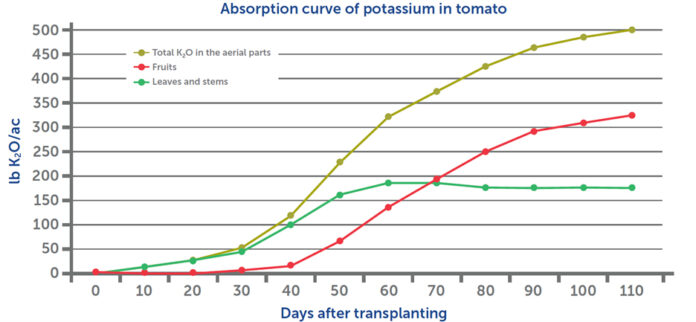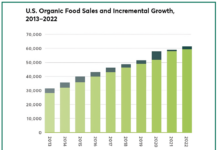Nitrogen, phosphorus and potassium (NPK) are three major nutrient components of any fertility program and are developed to maximize crop uptake at a given growth stage. Most nitrogen is applied in-season via fertigation (in California) utilizing common materials such as urea, UAN, CAN17 and CN9. Phosphorus is applied early season or in-season based on crop need and timing. Potassium has become a hot topic over the past 10 years and has evolved from the bulk of K2O being applied preplant or in dormancy to in-season applications to maximize efficiency. In this article, we will discuss the need of applying K in-season via fertigation in annual and perennial crops.
K as an Essential Plant Nutrient
The common practice of applying K preplant for annuals and in the dormant season for permanent crops is an effective method of applying K because it isn’t prone to leaching as negatively charged elements. However, depending on your soil type, K can tie up in heavy clays, especially when soils are dry. While K doesn’t readily leach through a soil profile it is important to have adequate K soil levels when the crop needs it, preferably in the vicinity of the feeder roots. This is especially important in the summer when evapotranspiration is at its peak. Reminder that K is heavily involved with the opening and closing of the stomata through the guard cells by turgor pressure, which is important for water use efficiency. Plants exposed to growing media with adequate levels of K are more tolerant to drought conditions, suffer less and negative effects on crop yield and quality due to drought conditions are reduced.
Liquid K Options
There are a variety of liquid K sources commonly used in California, all of which have their place in fertility programs. MOP and SOP have been standards for many years. With the introduction of potassium thiosulfate, many advisors have made it their standard due to its high K content (25%) and thiosulfate which adds additional benefits. Potassium hydroxide has also found a place in California agriculture and has increased in use. Potassium nitrate is fairly new to the California market and has been adopted in many programs due to its ability to blend with other fertilizers like CAN 17 and CN9. High-efficiency K products are widely utilized and, often, are proprietary to retail chains. With all that said, there are many, many options available to inject K in-season.
A key factor in deciding the most suitable K source for your fertilization program is to consider the secondary element that will be supplied with the K (e.g., with MOP, chloride will be added in the system; with SOP and KTS, sulfur will be added; with potassium nitrate, nitrogen will be added in the system; etc.). Therefore, considering the impact of these elements on the balance of the final nutrient solution will also influence crop yield and quality.
Current Practices
Given high fertilizer prices the last few years, we’ve backed off on fall-/winter-applied K applications, especially in almonds where we have successfully mined existing soil K. I am not a grower myself, but I hear from several advisors reducing K in the dormant season hasn’t yet influenced yield or K levels in tissues. This makes a case that perhaps we should be backing off on applying K in the fall/winter to permanent crops. And, perhaps, we should consider doing the same in annual crops, applying less K in preplant and taking a “spoon-feeding” approach, following the nutrient absorption demand of the crop by phenological stage. There is much data suggesting spoon feeding, or continuous fertigation, is beneficial to yield and quality.
The Benefits of Continuous Fertigation
Continuous fertigation is a nutrition management strategy that is built on the principle of small doses of mineral fertilizer with every irrigation event (some may call this ‘spoon-feeding.’) This type of management strategy requires knowledge of input interactions in the plant and soil interface, proper infrastructure for accurate input delivery and decision support tools for proper adaptation. Nitrate-based offerings are considered best suited for these spoon-fed strategies because they move predictably with water through the profile, are plant-available at the time of application and increase uptake of positively charged elements (cations) like calcium and magnesium among others. The agronomic benefits of spoon-feeding N through nitrates are undeniable, and the 4Rs (right source, right place, right rate and right time) should be considered with K as well regarding continuous fertigation.
Permanent Crops
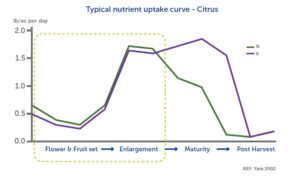
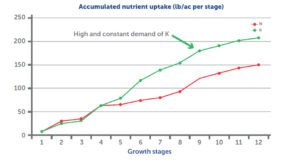
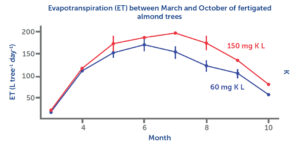
the hottest months of the year.
Annual Crops
Annual crops are managed slightly differently than perennial crops in that there may or may not be adequate soil K levels at planting based on the previous crop. A soil test is imperative to determine a fertility program for not just K but all essential nutrients. Given annual crops are on a shorter growth cycle, the importance of in-season K applications should be a priority, and, in many cases, can have a greater impact on yield and quality.
Applying K in-season via fertigation isn’t a new concept; most advisors’ recommendations include liquid K sources in their programs. We’ve seen in recent years reducing the amount of K we apply in the dormant season doesn’t affect yield or quality in most cases. However, following tissue K levels in-season in this case becomes even more important to avoid K deficiency. Rather than banking on existing soil K levels, we should be analyzing tissues consistently and creating prescriptive K recommendations based on the crops’ need. The data indicate that need is in-season. We have many K-based fertilizer options available in California, and we should determine which to use based on crop uptake, temperature, soil moisture and secondary element. And, of course, always consider the 4Rs concept to maximize uptake, efficiency and cost.
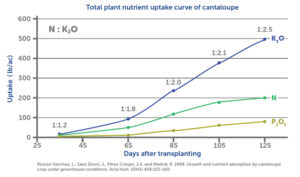
produce fruit.











